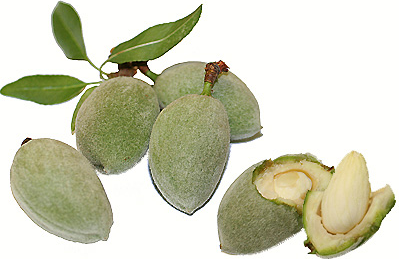


Green Almonds
Estimated Inventory, lb : 0
Description/Taste
Green almonds are immature nuts that are harvested whole and have a green tart fuzzy husk encasing the soft unformed nut. The crunch is definitely delightful but the green husk is sometimes bitter and can be very green tasting. The partly formed inner portion is an absolute sweet treat. Chefs especially love them for their distinct elegant taste. With each stage of development, the flavor and texture changes as the nut matures.
Seasons/Availability
Green almonds are available June through September.
Nutritional Value
Almonds are an excellent source of magnesium which contributes to strong bones and provide a good amount of vitamin E, riboflavin, phosphorus and copper plus are cholesterol- and sodium-free. Having the highest dietary fiber content of any nut or seed with more than three grams of fiber per ounce, almonds also contain more calcium than any other nut. Almonds are a good source of protein, although they are lacking the essential amino acid lysine but when combined with legumes which are high in lysine, total protein is achieved. Relatively high in fat, the fat is mostly unsaturated including sixty percent monounsaturated fat, the good variety.
Applications
To enjoy fresh, peel off green husk; remove shell; peel skin off nutmeat. Excellent raw, green almonds are delicious roasted in their shells. Place nuts in single layer on an ungreased baking sheet; bake in a 250-degree oven about ten minutes. Remove from oven; score seam of shell with knife to separate; remove nut. To blanch green almonds, soak in boiling water three to four minutes; immerse nuts into cold water immediately. The skins should rub off easily. To shell, place nuts in pan of cold water; bring quickly to a boil; drain; rinse in cold water. Great in salads and vegetable dishes. Add a tasty touch to main entrees. Marinate; serve as an unusual appetizer. To store, keep cool and dry. To freeze, place nuts in an ice cube tray; pour milk in each cube; freeze. Put frozen cubes in freezer bags.
Ethnic/Cultural Info
In Israel, green almonds are enjoyed as a snack dipped in salt. A favorite spring treat of the Mediterranean region is when almond trees start to bear fruit near Modi'in that lies in the rolling, rocky foothills of the Judean Mountains about halfway between the coastal plain to the west and the mountainous Jerusalem region to the east. The new young soft green almonds are edible though not nearly as tasty as the ripe nuts will be in a few months. There are special local recipes which make use of green almonds. Middle Eastern cuisine add green almonds to stews and desserts.
Geography/History
Almonds belong to the same group as roses, plums, cherries and peaches, members of the tribe Prunae of the natural order Rosaceae. Brought to California from Spain in the mid-1700s by Franciscan Padres, almond trees resisted the cool humid weather of the coastal missions. Not until the following century were almond trees successfully planted inland. Research and crossbreeding of the 1870's developed many popular almond varieties we still enjoy. Established in the Sacramento and San Joaquin regions, the almond industry was going strong in California's rich Central Valley by the turn of the twentieth century. Today almonds are California's largest tree nut crops. In the United States, California is the only state that commercially grows almonds for the marketplace. Green almonds are also known as Hara Badam.




